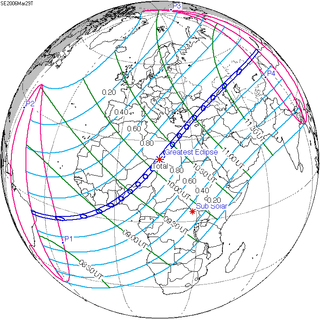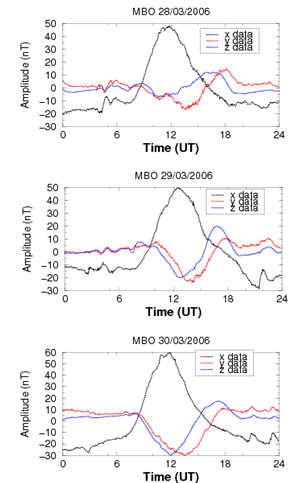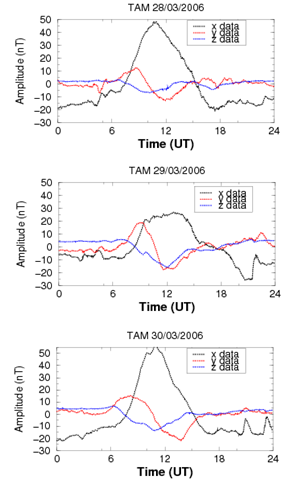-
Paper Information
- Paper Submission
-
Journal Information
- About This Journal
- Editorial Board
- Current Issue
- Archive
- Author Guidelines
- Contact Us
International Journal of Astronomy
p-ISSN: 2169-8848 e-ISSN: 2169-8856
2013; 2(4): 51-55
doi:10.5923/j.astronomy.20130204.01
Geomagnetic Diurnal Variation during the Total Solar Eclipse of 29 March 2006
Elvis V Onovughe
Department of Earth Sciences, Federal University of Petroleum Resources, Effurun, PMB 1221, Nigeria
Correspondence to: Elvis V Onovughe, Department of Earth Sciences, Federal University of Petroleum Resources, Effurun, PMB 1221, Nigeria.
| Email: |  |
Copyright © 2012 Scientific & Academic Publishing. All Rights Reserved.
Minutes records of all three components of the geomagnetic field (X, Y, Z) from three observatories in Africa (Bangui, BNG; Mbour, MBO and Tamanrasset, TAM) have been analysed to study the effect of the geomagnetic diurnal variation during the total solar eclipse of 29 March, 2006. The main eclipse induced changes in the geomagnetic diurnal variation was observed in Tamanrasset located very close to the total eclipse axis. The study revealed a decrease of about 20nT in the X (horizontal) component and an increase of about 10nT in the Y (east) component. These observed changes may be attributed to ionospheric effects due to decrease in electron concentration and ionospheric current density.
Keywords: Geomagnetic Variation, Total Solar Eclipse, Geomagnetic Field Components, Ionosphere
Cite this paper: Elvis V Onovughe, Geomagnetic Diurnal Variation during the Total Solar Eclipse of 29 March 2006, International Journal of Astronomy, Vol. 2 No. 4, 2013, pp. 51-55. doi: 10.5923/j.astronomy.20130204.01.
Article Outline
1. Introduction
- A total solar eclipse occurred on March 29, 2006 between 07.30 UT and 12.45 UT. The path of totality of the Moon's shadow began at sunrise in Brazil and extended across the Atlantic to Africa, travelling across West Africa to North Africa, from there across the Mediterranean Sea to Europe, where it ended at sunset. A partial eclipse was seen in the northern two-thirds of Africa, the whole of Europe, and Central Asia. The eclipse reaches the African mainland at 09:10 UT. The zone of totality is about 185km, and on the centreline it lasted for 3 minutes 30 seconds. The point of greatest eclipse is very near the Libyan border; the path width was about 183km, and the total eclipse lasted for 4 minutes 6 seconds. The path crosses Libya, and then just clips Egypt, before crossing into the Mediterranean at 10:40 UT.It is generally known that the quiet daily geomagnetic field variations are primarily due to the dynamo currents flowing in the ionosphere E-layer. Many researchers have studied the ionospheric dynamo and the regular quiet daily variation of the geomagnetic field[1,2,3,4,5]. During solar eclipse, part of the ionosphere is shielded from the sun’s heating and ionization radiation. This modifies the current pattern in this region and this is seen as a modification of the geomagnetic field observed at ground level[6]. Solar eclipses alter the ionospheric E-region process and as a result affect the regular geomagnetic daily variation known as Solar quiet (Sq), which originates primarily within the ionosphere. Therefore, the most significant changes appear in the ionosphere since the nature of the ionosphere is so closely tied to the radiation of the sun. As a result a loss of sunlight during the eclipse was expected to disturb the ionosphere. A change in the shape of the diurnal variation as recorded by geomagnetic ground stations in the vicinity must be expected, depending on the position of the shadow with respect to the Sq current system. These expected changes are small, about a few to a few tens of nanoteslas. The ionospheric effects during solar eclipse depends on several factors such as the level of solar activity, level of geomagnetic disturbance, geophysical conditions,geographical latitude and longitude and the local time[7]. Different researchers have studied geomagnetic field variations during solar eclipses with most of the results showing positive anomalies in the Y (east) component and a decrease in the X (horizontal) components[8,9,10,11,12]. Presented in this paper is the study investigating changes in the geomagnetic diurnal variation during the total solar eclipse of 29 March, 2006 as it affects some geomagnetic stations in Africa.
|
2. Materials & Methods
- Table 1 gives a summary of the observatories whose records were analysed, their coordinates, time of the eclipse and the percentage obscuration in each area. The eclipse totality path is as shown in figure 1. Total eclipse started in eastern Brazil at 08:34:29 and ended in northern Mongolia at 11:48:01; while the partial eclipse, which was visible over most of Africa, Europe, Middle East and most of Asia, started at about 07:36:53 and ended at 12:45:45. The greatest phase was at 10:12:23 and lasted for 4mins 07secs until 10:16:30 at a coordinates of 23.2N 16.7E.
 | Figure 1. Path of the eclipse of 29 March 2006 (Courtesy NASA) |
3. Results
- From the data of the three-component records at Bangui (BNG 4.3672°N, 18.5775°E), fig 2, one can identify no obvious changes in the regular Sq variation before, on or after the eclipse that can be attributed to the effect of the eclipse. The amplitude of the X-component for 28th and 29th were roughly the same, 40nT. The abrupt decrease in the X-component close to noon time may not be attributed to the effect of the eclipse as it was past the time of the greatest phase of the eclipse which was about 10:12am. A close look at the Y- and Z- components revealed no discernible change in amplitude or diurnal variation that is as a result of the eclipse. The increase in the amplitude on the 30th to about 55nT from the value of 40nT on the 28th and 29th, may just be a case of the regular Sq diurnal variation.
 | Figure 2. Diurnal variation from records of X, Y, Z at Bangui on March 28 to 30, 2006 |
 | Figure 3. Diurnal variation from records of X, Y, Z at Mbour on March 28 to 30, 2006 |
 | Figure 4. Diurnal Variation from records of X, Y, Z at Tamanrasset on March 28 to 30, 2006 |
4. Discussion and Conclusions
- Discussion: Due to the ionization by electromagnetic radiation from the sun, the ionosphere conducts. At night time the ions recombine rapidly and conductivity drops effectively to zero. Disregarding small tidal movements ascribed to the Sun’s and Moon’s gravitational attraction movement of the ionosphere is induced by thermal radiation from the Sun. This is switched off in the absence of direct solar radiation which occasionally occurs during solar eclipse – as a part of the ionosphere is shielded from the Sun’s heating and ionizing radiation. As a result the current pattern in the ionosphere is modified during solar eclipse, since the electron density in the ionosphere is closely tied to the radiation from the Sun. The effect of this might be detectable as a modification to the geomagnetic field observed at the ground level.In the current study, the changes connected with the total eclipse appeared only in Tamanrasset. Geomagnetic effects during total solar eclipse comparable to other observations are seen in Europe[8, 9, 11], where the eclipse occurred on 11 August 1999 and 1 August 2008 respectively.[8] noted an increase of 10nT in the Y component during the eclipse of 11 August 1999 and a decrease of 15nT in the X component.[9] found positive anomalies in the Y component with an amplitude increase of up to 15nT during the maximum phase of the eclipse. However, the effects of the horizontal and vertical components were not observed.[11] observed the main geomagnetic effects of the eclipse as a decrease of 8-10nT in the X component and an increase in the Y component with different ratios of quantities at different magnetic observatories. These observed changes are in accordance with those at Tamanrasset and presented here.Tamanrasset experienced the largest obscuration of the eclipse (Table 1), and the eclipse induced changes in the geomagnetic signature X, Y, Z components of the geomagnetic field are observed here because of its closeness to the path of totality of the eclipse. As a result, the solar radiation shielding by the lunar shadow modification of the ionosphere will be more pronounced over Tamanrasset than Mbour and Bangui, whose location are further away and experienced lower obscuration compared to Tamanrasset.The most obvious difference between the three days analysed at Tamanrasset is a decrease in the X component during the day of the eclipse by amplitude of about 20nT starting at about 10.00UT. Similarly, we observe an increase in Y component by amplitude of about 10nT as seen in Fig. 4. These effects seen at Tamanrasset may be attributed to a large percentage decrease in the solar ionizing radiation flux and the electron concentration in the ionosphere during the solar eclipse. This modification in the ionosphere can lead to decrease in the current density in the lower ionosphere and a local decrease in the north component of the magnetic induction of this current. Conclusions: From the data of the three-components of the geomagnetic field (X, Y, Z) analysed during the total solar eclipse of 29th March, 2006, the feature seen in TAM can be liken to an eclipse signature. In summary, the following changes were observed at Tamanrasset:Ø A decrease in the X (horizontal) component of the geomagnetic field from 50nT to 30nT, a decrease of 20nT;Ø An increase in the Y (east) component of the geomagnetic field from 10nT to 20nT, an increase of 10nT;Ø There is no observed change in amplitude or variation in the Z (vertical) component caused by the eclipse.Ø These observed changes may be attributed to ionospheric effects.Analysis of data from the other observatories, Mbour and Bangui, during the eclipse of 29 March 2006, failed to identify any distinct or discernible daily variation or eclipse effect in the geomagnetic field, which can be adduced to the eclipse. The results presented in this work are substantially in accordance with those of other works on total solar eclipse as seen in the 11 August 1999 and 1 August 2008 eclipses in Europe.
ACKNOWLEDGEMENTS
- The results presented in this paper were obtained at BNG, MBO and TAM magnetic observatories in March 2006. I am indebted to the staff of these observatories,INTERMAGNET and ISGI for providing high quality data and indices through http:// www. intermagnet. organd http:// www. isgi.cetp.ipsl.fr.
 Abstract
Abstract Reference
Reference Full-Text PDF
Full-Text PDF Full-text HTML
Full-text HTML